Review: LeEco LePro3
Nov 14, 2016, 3:45 PM by Eric M. Zeman
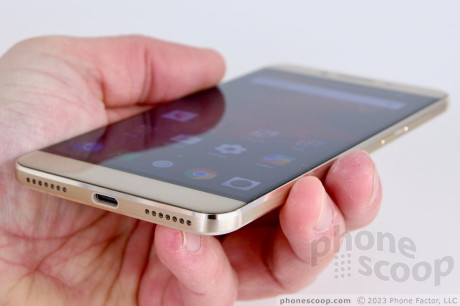
The LePro3 from LeEco is a flagship-class device that costs hundreds of dollars less than today's top phones, and yet it delivers almost-as-good performance. This unlocked Android Marshmallow smartphone works on AT&T and T-Mobile's LTE 4G networks and carries a bevy of video content apps. Find out what's great and what's not in Phonescoop's full review of the LeEco LePro3.
Is It Your Type?
LeEco is a Chinese phone maker looking for its first big break in the US market. The LePro3, a premium metal-and-glass Android handset, could be phone that gives it a toehold with US buyers. This inexpensive smartphone offers plenty of style and substance in an affordable package. If you're living LeUnlocked Life, LeEco's LePro3 offers lots to like.
Body
LeEco's first foray into the US is the LePro3. The LePro3 is a premium smartphone, but it's hardly a unique smartphone. It offers metal unibody construction with flagship-class specs and, shall we say, a familiar design. LeEco appears to have drawn at least some inspiration from Huawei, Asus, and other Asian Android phone makers in crafting the Pro3. I'd call the design almost generic.
The Pro3 has a metal chassis that forms the entirety of the rear panel and wraps around to form the sides as well. It's polished to a shine along the edges and I genuinely like the reflective chamfers. The metal rear panel has a brushed finish that's coated in a thin veneer of something akin to lacquer. From some angles it almost looks as though it might be sticky to the touch (it isn't).
I'd say the Pro3 is an average size for a device with a 5.5-inch display. It's in line with phones like the OnePlus 3 and ZTE Axon 7, which have the same screen size. LeEco did a decent job in minimizing bezel thickness. It's fairly easy to use one-handed, but I think many people will find it easier to use with two hands. The phone is slim enough (7.5 mm) that you shouldn't have any trouble storing it in your pocket.
The materials and build quality are very, very good. The metal pieces are all joined snugly and the glass front panel is fitted into the frame tightly. The lacquer-y finish and strength of the metal chassis gives the Pro3 a strong, flagship feel. The phone doesn't feel cheap in the least.
Matching metal bezels above and below the display define the screen's dimensions. The side bezels are incredibly thin, which I appreciate. The black 2.5D glass is curved near the seam where it joins the sides of the metal chassis. It is fitted in perfectly. The sensors surrounding the speaker are symmetrical, which I appreciate. Capacitive controls (multitask, back, home) are hidden in the bezel below the display. They light up and become visible only upon being touched, and function well. The home button is LeEco's logo, which is kind of neat.
You'll find two hardware buttons tucked into the right edge of the phone. The upper button is the volume toggle and the lower button is the screen lock key. The profiles are rather slim, but the buttons offer decent travel and feedback. It would help if the screen lock key had a slightly different texture to it to set it apart from the larger toggle. Thankfully LeEco carved out a rather deep channel between the buttons; this helps you discern where one ends and the other begins. LeEco put the SIM tray in the left edge of the phone. The tray does not accommodate memory cards.
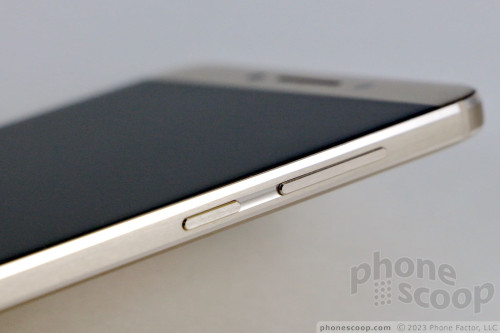
A small, black sensor and even smaller microphone hole are the only two elements interrupting the otherwise smooth metal of the top edge. The Pro3 uses a USB-C connector and includes a speaker. Both are on the bottom edge. I like that LeEco drilled an even number of holes into the bottom edge. Symmetry is always appealing. There is no headphone jack.
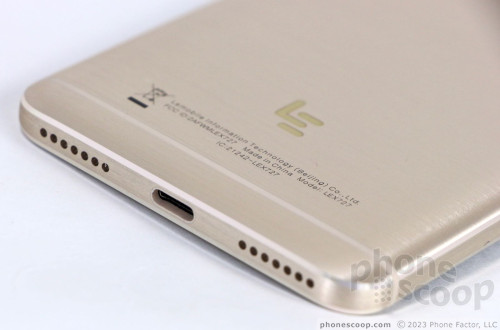
I'd call the rear panel a bit plain. It's a nearly flat metal surface that has little character going for it. The back curves just a small amount right as it reaches the side, top and bottom edges. The fingerprint reader stands out more than anything else thanks to its mirror-like reflectiveness. In fact, you can practically use the fingerprint sensor to check your hair or makeup. The reader is a cinch to find and use without looking as it is indented a bit from the rear surface. You'll notice the large, squircle-ish camera module above the fingerprint reader. The module is rather sharp along the edge, where the thin chamfers don't help smooth out the metal quite enough. Antenna lines run side-to-side across the rear panel.
The unibody design means the chassis cannot be opened and the battery is inaccessible.
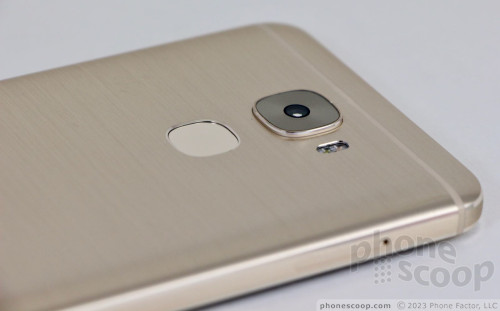
As far as the hardware goes, the LePro3 is a fine phone. The design isn't the most inspiring I've seen, but it's a classy bit of kit that doesn't look, feel, or behave cheap. It matches its price point well.
Screen
Unlike many of its competitors, the LePro3 does not have a quad HD screen. Instead, LeEco picked a full HD (1920 x 1080 pixel) panel to fill out the 5.5-inch display. It's a decent screen and I'm not complaining, merely pointing out that some phone makers offer more bang for the buck. I'd call the Pro3's display sharp, bright, and colorful. The resolution is certainly adequate for normal use like email, social networks, video, and so on. I was really pleased with HD content I streamed from YouTube. The VR experience does suffer a bit, however, without a greater number of pixels. Brightness is good for indoor and outdoor use, though the auto-brightness tool isn't as quick as I'd like it to be. I found myself manually adjusting the brightness up when stepping outside. Colors are accurate, which I appreciate, and viewing angles are pretty good, too.
Signal
The LePro3 is sold unlocked with decent support for US LTE Bands (2, 4, 5, 12, and even AT&T's 29 and 30.) You can use it on the networks of AT&T and T-Mobile, and their prepaid brands, Cricket and MetroPCS, respectively. I tested it on both AT&T and T-Mobile around NYC and it worked very well.
Calls connected on the first dial consistently. The phone didn't drop any calls at highway speed on AT&T's network, but did on T-Mobile's. This is on par with other phones I've tested on AT&T and T-Mobile over the same course. The phone did miss at least one call on each network when under weak coverage. This is also fairly typical. As far as data performance goes, LTE was quick across the board. The Pro3 offered more consistently speedy data on AT&T's network, but reached higher peaks and valleys on T-Mobile's. All you need to know is that the Pro3 had no trouble streaming HD video and high bit-rate music over LTE.
Sound
LeEco assembled a fine voice phone in the Pro3. Calls made normally via the earpiece were crystal clear. Voices sounded warm and present during calls. Clarity was very, very good, but I wish the earpiece produced a bit more volume. Those I spoke to through the Pro3 said I was "very loud" to their ears.
The speakerphone isn't quite as good. If you're in a quiet space such as room with the door closed, you can experience reasonably clear calls at acceptable volumes. Even a modest amount of noise will force you to raise the volume and therein introduce some rather gross distortion. You can hear calls in a moving car, but it's not easy.
Ringers and alerts are reasonably loud, but not as loud as I'd like. The vibrate alert is just barely acceptable. I definitely missed calls because I couldn't hear or feel the phone when it was in my pocket.
Last up, the Pro3 supports stereo sound. It pushes sound out the earpiece and the set of the holes drilled on the bottom edge. I'm happy to report that the Pro3 offers fairly balanced sound this way, with the bass and treble signals being distributed evenly across both speakers. Some phones I've reviewed this year (HTC 10, iPhone 7) offer a less balanced sound. Moreover, the phone includes Dolby Atmos software for really tweaking the sound and optimizing it to headphones. As long as you don't mind spending 5 minutes fiddling with it, it delivers solid sound enhancement. Of course, you'll need to use the USB-C headphones in the box or an adapter to make use of this functionality. (Note: LeEco is using digital signals over the USB-C connector that they call CDLA. It's not clear that this is compliant with the new standard — Audio Device Class 3.0 — from the USB-IF, which has both analog and digital modes. LeEco hasn't responded to our queries on the matter.)
Battery
The Pro3 has one of the biggest batteries in any class. At 4,070 mAh, LeEco claims the Pro3 can chew through 33 hours of talk time or 49 hours of media playback. All I can tell you is: I never even came close to killing off the battery. After an absolutely brutal day of testing (all radios on, screen brightness way up, lots of streamed media), I was still only able to drain about 50% from the battery. It often had 25% left at lunchtime on Day Two. In other words, this thing is a power master, a battery monster, a lithium-ion beast.
LeEco installed some serious power management software. The battery saver function provides a detailed analysis of how much battery life is remaining and lets you toggle on/off a huge number of features to extend battery life even further. For example, you can set prevent apps from using too much battery by setting limits, schedule power offs/ups, as well as prevent power management tools from impacting core/key apps
Last, the device includes Qualcomm's Quick Charge 3.0 and a high-wattage charger. LeEco claims the charger delivers a 33% charge in about 20 minutes. That's an accurate claim, based on my observations.
The Pro3 is a phone for powerhogs.
Bluetooth, GPS, NFC, WiFi
The Bluetooth 4.2 radio performed excellently. I used it to stream music to a speaker all afternoon whilst raking leaves and it never faltered. The music sounded great, by the way. So too did voices made via Bluetooth through dedicated headsets and my car's hands-free system. The Pro3's Bluetooth radio was above average in all respects.
I happily paired the Pro3 with some accessories thanks to the on-board NFC radio. You can also use NFC to set up Android Pay if you wish, but you'll have to download that app on your own.
The GPS radio also performed well. It provided a quick location in about 1 second. Accuracy was initially only as good as maybe 35 or 50 feet, but after a few more seconds the Pro3 was able to zero in to about 10 feet. The GPS radio worked flawlessly with Google Maps and the phone served as a fine real-time navigation tool.
The Pro3 has dual-band WiFi and it was very, very fast.
Comments
LeEco LePro3
I have been on countless websites and none state that this phone is compatible with Band 12 and Band 17. Just 2 and 4.
https://www.phonescoop.com/phones/phone.php?p=5320 »
HD Calling?
I didn't think non AT&T branded phones would work with AT&T features such as their HD calling?


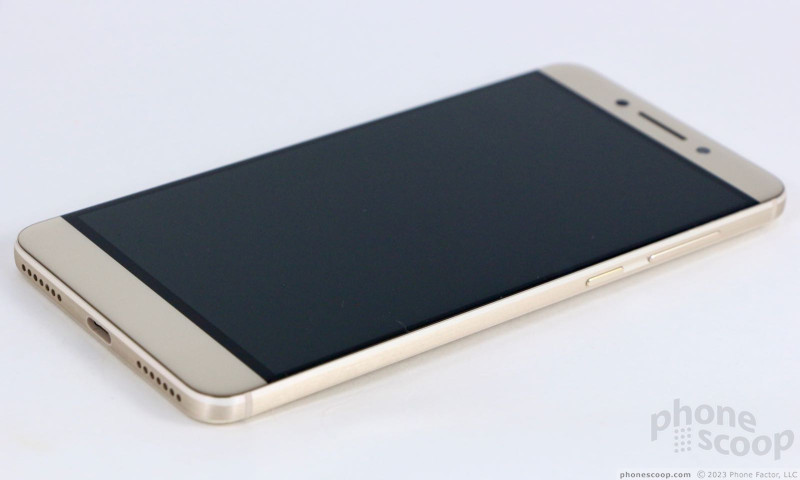
















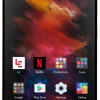 LeEco EUI Update Adds App Drawer to Le Pro3 and Le S3
LeEco EUI Update Adds App Drawer to Le Pro3 and Le S3
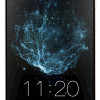 LeEco Selling the Pro3 and S3 Through Target
LeEco Selling the Pro3 and S3 Through Target
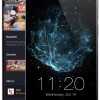 LeEco Details the LePro3 with Snapdragon 821
LeEco Details the LePro3 with Snapdragon 821
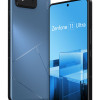 Asus Goes Big with Zenfone 11 Ultra
Asus Goes Big with Zenfone 11 Ultra
 LeEco Le Pro3
LeEco Le Pro3





